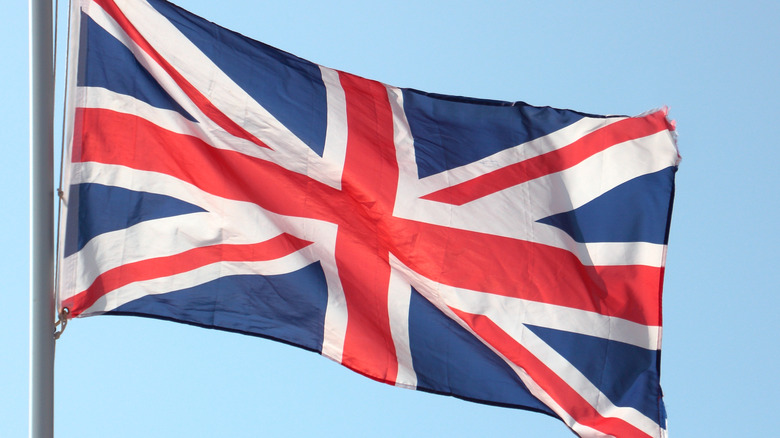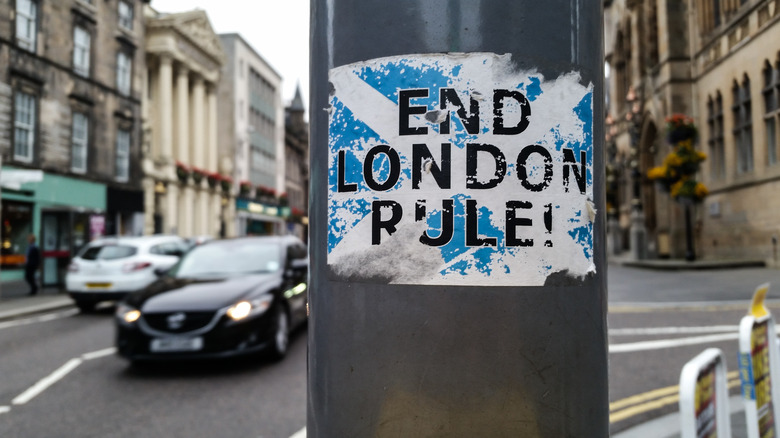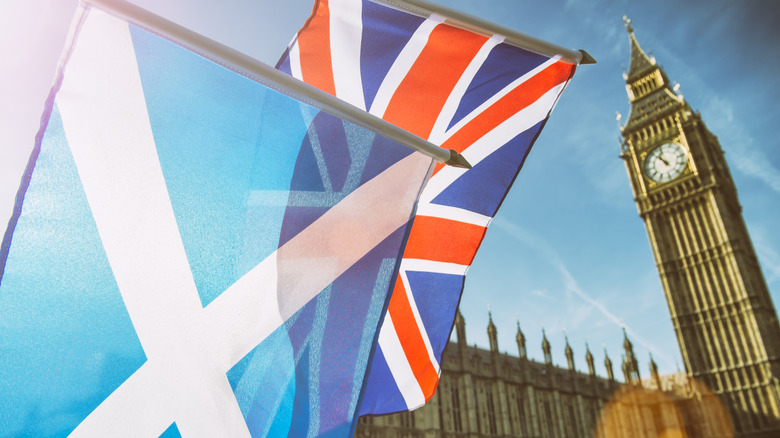What Would Happen To The Union Flag If Scotland Left The UK?
The United Kingdom's flag — referred to as the Union Jack — is one of the most instantly recognizable national flags in the world. What's cool about the Union Jack is that according to The Royal Family, its design is a combination of the flags belonging to the three countries that joined to form the United Kingdom: the kingdoms of England and Wales, Scotland, and Ireland. Ireland was part of the United Kingdom from 1801 until 1922, at which point Ireland withdrew from the United Kingdom, but Northern Ireland stayed (via Britannica).
The three crosses that combine to form the Union Jack are the cross of St. George, which is red on a white background; the cross of St. Andrew, the patron saint of Scotland, which is a white diagonal cross on a blue background; and the cross of St. Patrick, the patron saint of Ireland, which is a diagonal red cross on a white background. Overlaid on top of each other, each of these symbols combine to form the Union Jack.
But what happens if one of the nations were to leave the United Kingdom? It happened before with Ireland, but the flag remained intact. However, there is now a movement for Scotland to leave the United Kingdom and become an independent nation, per The Week. Does that mean that Scotland would take their blue and white part of the Union Jack with them?
Scottish independence movement
According to The Week, Scotland has been part of Great Britain since 1707, but there have been previous pushes for the country to gain independence, including a recent — and ultimately unsuccessful — movement in 2014. That year, Scots voted on whether or not to separate from the U.K., but the idea of leaving was voted down, 55% to 45%, in favor of staying a part of the United Kingdom.
Undeterred, there was still enough support for Scottish independence that the topic has come up again in 2022. According to NPR, the Scottish government is already relatively autonomous, and Scottish First Minister Nicola Sturgeon announced that her country would try to put another independence referendum on the ballot.
"This is a U.K. government that has no respect for democracy," Sturgeon said. "It has no regard for the rule of law either. That means if we are to uphold democracy here in Scotland, we must forge a way forward, if necessary, without a Section 30 order." According to The Scotsman, Section 30 is part of the Scotland Act 1988 that gives the Scottish government the ability to pass laws, something that was previously reserved only for the U.K. parliament.
The fate of the Union Jack
So, what would happen to the Union Jack if Scotland were to leave the United Kingdom? This topic came up ahead of the 2014 referendum on Scottish independence that was voted down, and the truth of the matter is no one is really sure, but that doesn't mean there's a shortage of ideas about how to change the flag, or even keep it as is.
According to the BBC, back in 2013, Charles Ashburner, the chief executive of the Flag Institute, polled members of his organization and found that most of the members were in favor of maintaining the current Union Jack design, but they did offer some hypothetical alternatives. The first was to simply drop the Scottish flag's white diagonal cross and blue field from the current design. This would leave just the English flag's cross of St. George and Northern Ireland's cross of St. Patrick.
Another thought was that changing the flag could be a chance to incorporate some symbolism tied to Wales, which isn't represented on the current Union Jack. The idea would be to make the bottom half of the flag's background green as a nod to the Welsh flag. Other designs the Flag Institute proposed maintained Scottish symbolism, as while they would potentially leave the United Kingdom, they would still fall under the same monarchy.


